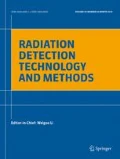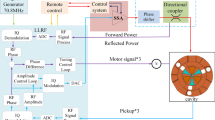Abstract
Background
The Beijing Electron Positron Collider (BEPCII) is a high-brightness collider and operates in compatible mode of synchronous light source. This summer, BEPCII spare cavity, which was all made in China, had been put into BEPCII operation, and the LLRF system for the spare cavity was also upgraded at the time.
Purpose
The purpose is to stably control the amplitude and phase of the spare cavity and apply digital technology to achieve some intelligent functions.
Methods
The digital method is applied in the superconducting cavity feedback control of the accelerator and it introduces the digital technology of the RF low-level control system that has been stably applied to the BEPCII spare cavity operation. In addition, some functions such as quench detector and input protection as well as horizontal test have been realized in the RF system operation.
Results
The amplitude and phase stabilities of cavity voltage with beam in the digital LLRF have reached \(\pm 0.09\%\) (RMS) and \(\pm 0.055^{\circ }\) (RMS), respectively.
Conclusion
The BEPCII spare cavity with digital LLRF system has been stably operated for 2 months. The DLLRF system has been reliable and stable, and the performance of the spare cavity with beam was very good.













Similar content being viewed by others
References
W.-M. Pan , Y. Sun, G.-W. Wang, J.-P. Dai, Accelerator Division, RF Group, BEPCII RF system design report. in BEPCII major renovation project preliminary design, vol. 3 (Institute of High Energy Physics (IHEP), Beijing, China, 2010)
Z.-G. Zhang, Y.-B. Zhao, K. Xu, Digital LLRF controller for SSRF booster RF system upgrade. Nucl. Sci. Tech. 26, 030106 (2015)
Altera Corporation, in Stratix-II Device Handbook, vol. 1 (Altera Corporation, San Jose, CA, 2011)
R. Garoby, Low level RF building blocks, CERN accelerator school RF engineering for particle accelerator, Oxford, 1991, in CERN92-03 (1992)
C. Ziomek, P. Corredoura, Digital I/Q Demodulator (Stanford Linear Accelerator Center, Stanford, 1995)
Y.-B. Zhao, RF low-level control and direct RF feedback, Ph.D. thesis, pp. 65–70 (2007)
T.-M. Huang, H.-Y. Lin et al., Some experiences with BEPCII SRF system operation. CPC 40(6), 067001 (2016)
Y. Yamamoto, K. Akai, K. Ebihara, T. Furuya, K. Hara, T. Honma, K. Hosoyama, A. Kabe, Y. Kojima, S. Mitsunobu, Y. Morita, H. Nakai, K. Nakanishi, M. Ono, H. Hara, K. Sennyu, T. Yanagisawa, T. Kanekiyo, T. Nakazato, HORIZONTAL Test for cavities in KEKB, in Proceedings of SRF 2007, Peking University, Beijing, WEP27 (2007)
Author information
Authors and Affiliations
Corresponding author
Rights and permissions
About this article
Cite this article
Wang, MY., Sun, Y., Wang, GW. et al. The application of digital technology in BEPCII RF system. Radiat Detect Technol Methods 2, 16 (2018). https://doi.org/10.1007/s41605-018-0044-4
Received:
Revised:
Accepted:
Published:
DOI: https://doi.org/10.1007/s41605-018-0044-4




